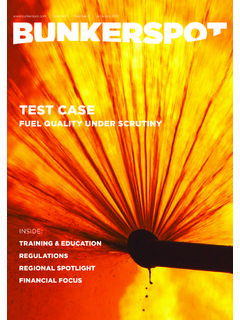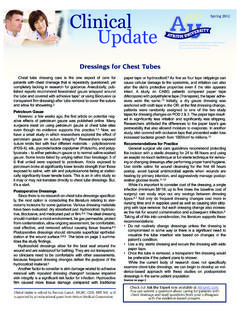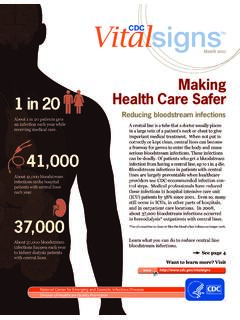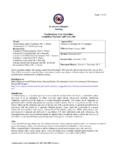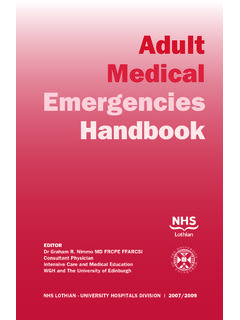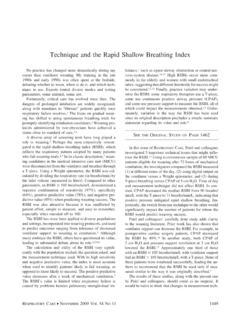Transcription of REVISED GUIDELINES FOR THE PERFORMANCE AND …
1 I:\CIRC\MSC\01\ INTERNATIONAL MARITIME ORGANIZATION 4 ALBERT EMBANKMENT LONDON SE1 7SR Telephone: 020 7735 7611 Fax: 020 7587 3210 IMO E Ref. T4 10 June 2009 REVISED GUIDELINES FOR THE PERFORMANCE AND TESTING CRITERIA, AND SURVEYS OF FOAM CONCENTRATES FOR FIXED FIRE-EXTINGUISHING SYSTEMS 1 The Maritime Safety Committee, at its sixtieth session (6 to 10 April 1992), approved GUIDELINES for the PERFORMANCE and testing criteria, and surveys of low-expansion foam concentrates for fixed fire-extinguishing systems ( ). 2 The Committee, at its sixty-eighth session (28 May to 6 June 1997), approved GUIDELINES for the PERFORMANCE and testing criteria, and surveys of expansion foam concentrates for fixed fire-extinguishing systems of chemical tankers ( ).
2 3 The Sub-Committee on Fire Protection, at its fifty-third session (16 to 20 February 2009) reviewed the aforementioned GUIDELINES and made amendments to the test methods for both types of foam concentrates which combined the test procedure into one document. 4 The Committee, at its eighty-sixth session (27 May to 5 June 2009), after having considered the above proposal by the Sub-Committee on Fire Protection, at its fifty-third session, approved the REVISED GUIDELINES for the PERFORMANCE and testing criteria, and surveys of foam concentrates for fixed fire-extinguishing systems, as set out in the annex. 5 Member Governments are invited to apply the annexed GUIDELINES when approving foam concentrates for fixed fire-extinguishing systems onboard tankers and chemical tankers and bring them to the attention of ship designers, shipowners, equipment manufacturers, test laboratories and other parties concerned.
3 6 This circular supersedes and , and Type approvals conducted in accordance with the aforementioned GUIDELINES should remain valid until 1 July 2012. ** I:\CIRC\MSC\01\ ANNEX REVISED GUIDELINES FOR THE PERFORMANCE AND TESTING CRITERIA, AND SURVEYS OF FOAM CONCENTRATES FOR FIXED FIRE-EXTINGUISHING SYSTEMS 1 GENERAL Application These GUIDELINES apply to the foam concentrates used for fixed deck foam fire-extinguishing systems required for tankers by SOLAS regulations II-2 and chapter 14 of the International Code for Fire Safety Systems (FSS Code), and chemical tankers as specified by SOLAS regulation II-2 and the International Code for the Construction and Equipment of Ships Carrying Dangerous Chemicals in Bulk (IBC Code).
4 These GUIDELINES also apply to foam concentrates for fixed foam fire-extinguishing systems in machinery spaces according to chapter 6 of the FSS Code and to portable foam applicators according to chapter 4 of the FSS Code. These GUIDELINES do not apply to the foam generating equipment, only the foam concentrate. Definitions For the purpose of these GUIDELINES , the following definitions apply: Foam (fire fighting) is an aggregate of air filled bubbles formed from an aqueous solution of suitable foam concentrate. Foam solution is a solution of foam concentrate and water. Foam concentrate is a liquid which, when mixed with water in the appropriate concentration, gives a foam solution.
5 Expansion ratio is the ratio of the volume of foam to the volume of foam solution from which it was made. Spreading coefficient is a measurement of the ability of one liquid to spontaneously spread across another. 25% (50%) drainage time is the time for 25% (50%) of the liquid content of a foam to drain out. Gentle application is the application of foam to the surface of a liquid fuel via a backboard, tank wall or surface. Sediment is insoluble particles in the foam concentrate. Aqueous film-forming foam concentrate (AFF) is a foam concentrate based on a mixture of hydrocarbon and fluorinated surface active agents. Alcohol resistant foam concentrate (AR) is a foam concentrate that is resistant to breakdown when applied to the surface of alcohol or other polar solvents.
6 ANNEX Page 2 I:\CIRC\MSC\01\ Film-forming fluoroprotein foam concentrate (FFFP) is a foam concentrate which has the ability to form an aqueous film on the surface of some hydrocarbons. Fluoroprotein foam concentrate (FP) is a protein foam concentrate with added fluorinated surface active agents. Protein foam concentrate (P) is a foam concentrate made from hydrolyzed protein materials. Synthetic foam concentrate (S) is a foam concentrate based on a mixture of hydrocarbon surface active agents and which may contain fluorocarbons with additional stabilizers. Type A foam concentrates are alcohol-resistant or multi-purpose foam concentrates. Type B foam concentrates are all regular type foam concentrates that are not alcohol-resistant, including fluoroprotein and aqueous film-forming (AFF) foam concentrates.
7 2 SAMPLING PROCEDURE The sampling method should ensure representative samples which should be stored in filled containers. The sample size should be: .1 2 x 20 l containers (or other standard shipping containers) for type tests (see section 3); and .2 2 l for periodical controls (see section 4). 3 TESTS FOR TYPE APPROVAL OF FOAM CONCENTRATES For foam concentrate type approval, the tests under paragraphs to below should be performed by the foam concentrate manufacturer at laboratories acceptable to the Administration. Freezing and thawing Before and after temperature conditioning in accordance with paragraph below, the foam concentrate should show no visual sign of stratification, non-homogeneity or sedimentation.
8 Freezing and thawing test: .1 apparatus: .1 freezing chamber, capable of achieving temperatures required, as stated in paragraph below; .2 polyethylene tube, approximately 10 mm diameter, 400 mm long and sealed and weighted at one end, with suitable spacers attached. Figure 1 shows a typical form; and .3 500 ml cylinder, approximately 400 mm high and 65 mm in diameter. ANNEX Page 3 I:\CIRC\MSC\01\ .2 procedure: .1 set the temperature of the freezing chamber to a temperature which is 10 C below the freezing point of the sample measured in accordance with standard BS 5117, section (excluding in the standard). To prevent the glass measuring cylinder from breaking, due to expansion of the foam concentrate on freezing, insert the tube into the measuring cylinder, sealed end downward, weighted if necessary to avoid flotation, and the spacers ensuring it remains approximately on the central axis of the cylinder.
9 Place the cylinder with the sample in the chest, cool it and maintain at the required temperature for 24 h. At the end of this period, thaw the sample for not less than 24 h and not more than 96 h in an ambient temperature of 20 to 25 C; .2 repeat the procedure described in the above subparagraph three times to give four cycles of freezing and thawing; and .3 condition the sample for seven days at 60 C followed by one day at room temperature. The sample shall then be examined for visual signs of stratification, non-homogeneity or sedimentation. Heat stability An unopened 20 l container (or other standard shipping container), as supplied by the manufacturer from a production batch, should be maintained for seven days at 60 C, followed by one day at room temperature.
10 Following this conditioning, the foam liquid after agitating/stirring will be subjected to the fire test as per subsection Only fire tests as per subsection should be performed with the heat conditioned sample. Sedimentation Any sediment in the concentrate prepared in accordance with section 2 should be dispersible through a 180 m sieve, and the percentage volume of sediment should not be more than when tested in accordance with paragraph below. The test should be carried out as follows: .1 apparatus: .1 graduated centrifuge tubes; .2 centrifuge operating at 6,000 100 m/s2; .3 180 m sieve complying with standard ISO 3310-1; and .4 plastic wash bottle. Note: a centrifuge and tubes complying with standard ISO 3734 are suitable; and ANNEX Page 4 I:\CIRC\MSC\01\.


